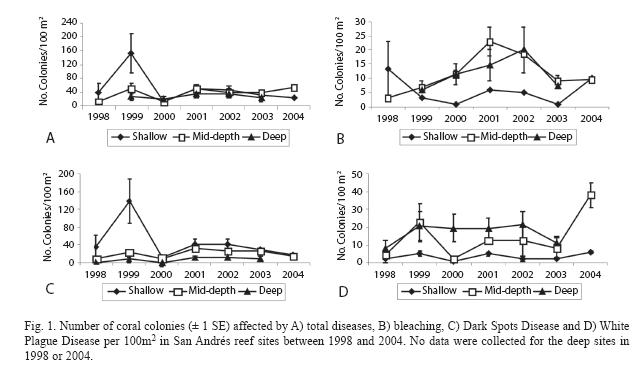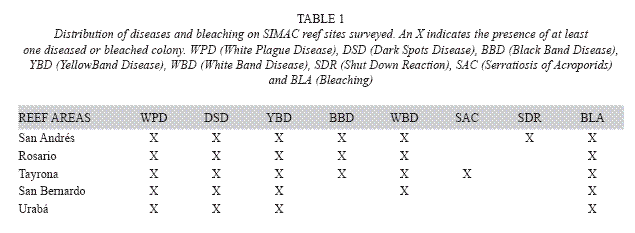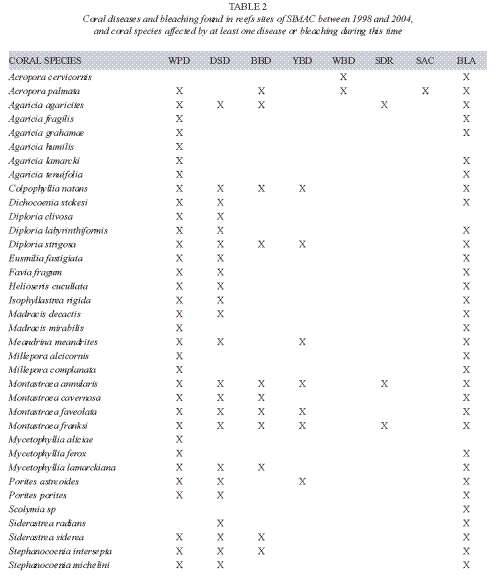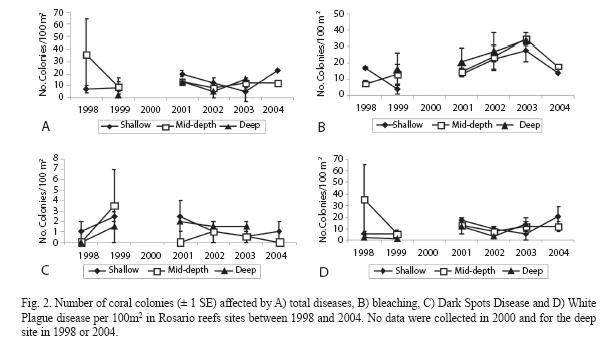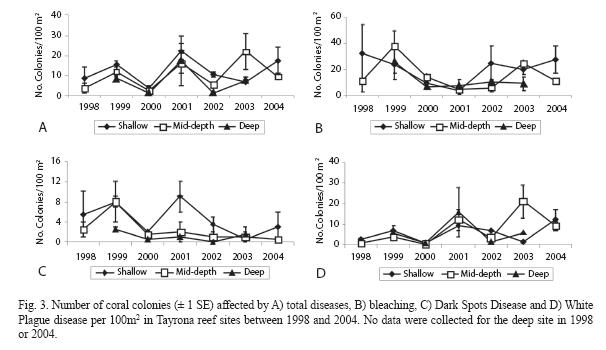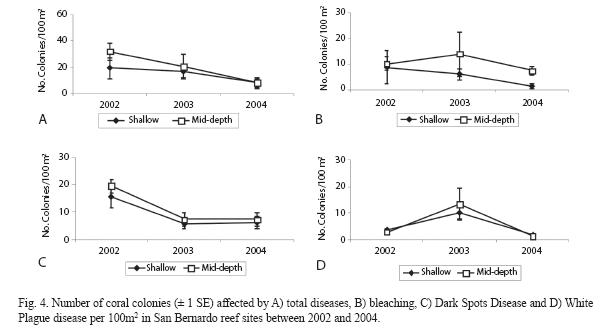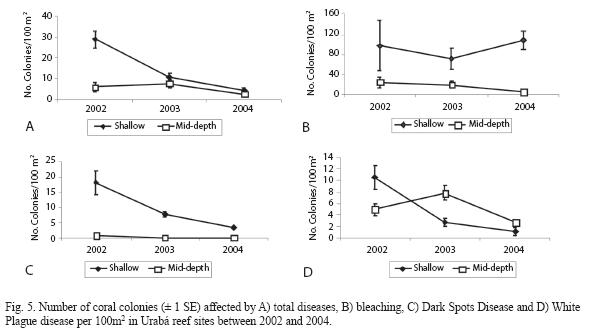Services on Demand
Journal
Article
Indicators
-
 Cited by SciELO
Cited by SciELO -
 Access statistics
Access statistics
Related links
-
 Similars in
SciELO
Similars in
SciELO  uBio
uBio
Share
Revista de Biología Tropical
On-line version ISSN 0034-7744Print version ISSN 0034-7744
Rev. biol. trop vol.58 suppl.1 San José May. 2010
Coral diseases and bleaching on Colombian Caribbean coral reefs
Raúl Navas-Camacho1, Diego Luis Gil-Agudelo1, Alberto Rodríguez-Ramírez1, María Catalina Reyes-Nivia1 & Jaime Garzón-Ferreira1, 2
1. Instituto de Investigaciones Marinas y Costeras, INVEMAR, Punta de Betín, Zona Portuaria, Santa Marta, Colombia; rnavas@invemar.org.co, diego.gil@invemar.org.co, betorod@invemar.org.co, catareyes@invemar.org.co, jgarzon@invemar.org.co
2. Present address: Brewster Academy, 80 Academy Drive, Wolfeboro, NH 03894, anisotremus@gmail.com
Since 1998 the National Monitoring System for the Coral Reefs of Colombia (SIMAC) has monitored the occurrence of coral bleaching and diseases in some Colombian coral reefs (permanent stations at San Andres Island, Rosario Islands, Tayrona, San Bernardo Islands and Urabá). The main purpose is to evaluate their health status and to understand the factors that have been contributing to their decline. To estimate these occurrences, annual surveys in 126 permanent belt transects (10x2m) with different depth intervals (3-6 meters, 9-12 meters and 15-18 meters) are performed at all reef sites. Data from the 1998-2004 period, revealed that San Andrés Island had many colonies with diseases (38.9 colonies/m2), and Urabá had high numbers with bleaching (54.4 colonies/m2). Of the seven reported coral diseases studied, Dark Spots Disease (DSD), and White Plague Disease (WPD) were noteworthy because they occurred in all Caribbean monitored sites, and because of their high interannual infection incidence. Thirty five species of scleractinian corals were affected by at least one disease and a high incidence of coral diseases on the main reef builders is documented. Bleaching was present in 34 species. During the whole monitoring period, Agaricia agaricites and Siderastrea siderea were the species most severely affected by DSD and bleaching, respectively. Diseases on species such as Agaricia fragilis, A.grahamae, A. humilis, Diploria clivosa, Eusmilia fastigiata, Millepora complanata, and Mycetophyllia aliciae are recorded for first time in Colombia. We present bleaching and disease incidences, kinds of diseases, coral species affected, reef localities studied, depth intervals of surveys, and temporal (years) variation for each geographic area. This variation makes difficult to clearly determine defined patterns or general trends for monitored reefs. This is the first long-term study of coral diseases and bleaching in the Southwestern Caribbean, and one of the few long term monitoring studies on coral diseases worldwide. Rev. Biol. Trop. 58 (Suppl. 1): 95-106. Epub 2010 May 01.
Key words: Monitoring, SIMAC, coral diseases, bleaching, coral reefs, Colombian Caribbean.
Resumen
Desde 1998 el "Sistema Nacional de Monitoreo de Arrecifes Coralinos de Colombia" SIMAC, ha observado la ocurrencia de enfermedades coralinas y blanqueamiento en arrecifes colombianos (estaciones fijas en la Isla de San Tayrona, Islas del Rosario, Islas de San Bernardo y Urabá Chocoano). Para estimar la ocurrencia se ha examinado anualmente un total de 126 bandas permanentes (10x2m), dispuestas en diferentes rangos de profundidad en las áreas arrecifales objeto de estudio. El análisis de la información obtenida entre 1998 y el 2004 revela que San Andrés presenta altos promedios de colonias enfermas (38.9 colonias/100m2) y que Urabá exhibe ésta condición para el blanqueamiento (54.4 colonias/100m2). Del total de siete enfermedades detectadas, se destacan por su presencia en todas las áreas y la ocurrencia interanual, los Lunares Oscuros (DSD) y la Plaga Blanca (WPD). Un total de 35 especies de corales pétreos fueron registradas con al menos una enfermedad y se encontró una alta ocurrencia de enfermedades en las principales especies formadoras de arrecifes. El blanqueamiento se halló presente en 34 especies. Mientras WPD se halló en más especies (33), la DSD se registró un mayor número de veces. Agaricia agaricites fue la especie con mayor número de registros de DSD; por otra parte Siderastrea siderea fue vista un mayor número de veces con signos de blanqueamiento. Especies como Agaricia fragilis, A.grahamae, A. humilis, Diploria clivosa, Eusmilia fastigiata, Millepora complanata, Mycetophyllia aliciae y Siderastrea radians son registradas por primera vez con presencia de enfermedades en Colombia. Cada área geográfica presentó variaciones espaciales (localidades, rangos de profundidad) y temporales (años) en cuanto a las prevalencias, tipos de enfermedades y especies de corales afectadas, que dificultan determinar patrones claramente definidos o tendencias generales para los arrecifes evaluados.
Palabras clave: Monitoreo, SIMAC, enfermedades coralinas, blanqueamiento, arrecifes coralinos, Caribe colombiano.
During the last three decades coral reefs have suffered extensive loss of living tissue mainly due to coral bleaching (Glynn 1993, Wilkinson 2000, Richard & Precht 2001, Aronson et al. 2002, Rosenberg & Ben-Haim 2002) and coral diseases (Peters 1997, Santavy & Peters 1997, Goreau et al. 1998, Green & Bruckner 2000, Sutherland et al. 2004). Disease is defined as "An interruption, cessation, or disorder of body function, system, or organ" (Stedman 2000). Since 1973 when the first coral disease was documented by Antonious, the numbers of illnesses that affect corals have increased rapidly, affecting reefs and reducing living tissue in these ecosystems throughout the world (Green & Bruckner 2000, Rosenberg & Ben-Haim 2002, Sutherland et al. 2004). Usually, these affections cause the death of coral tissue, but their etiology is poorly understood, and the pathogenic agent responsible for most diseases are still unknown (Green & Bruckner 2000, Rosenberg & Ben-Haim 2002, Sutherland et al. 2004). Some of the most commonly observed diseases that affect Caribbean stony corals are Black Band Disease (BBD), White Band Disease (WBD), White Plague (WPD), Dark Spots Disease (DSD), Yellow Band Disease (YBD), and White Pox (WPx) (Richardson et al. 1997, 1998b, Gil-Agudelo & Garzón-Ferreira 2001, Patterson et al. 2002, Gil-Agudelo et al. 2004, Borger 2005).
Coral bleaching is defined as the loss of symbiotic algae and/or their photosynthetic pigments by coral polyps and has been frequently associated with drastic changes in the physicochemical conditions of the water (temperature, salinity, transparency, among others), extreme low tides and diseases (Brown 1997, Banin et al. 2000, Rosenberg & Ben-Haim 2002, Sutherland et al. 2004). In most cases, if after several weeks or months the process responsible for bleaching is not reversed, the coral will die mainly because part of the nutrients used by corals are derived from their symbiotic relation with zooxanthellae (Glynn 1993, Rosenberg & Ben-Haim 2002, Sutherland et al. 2004). In cases where bleaching has not caused coral mortality, a decrease in the reproductive capability of corals, and disruption of the normal coral development has been observed (Rosenberg & Ben-Haim 2002). Extensive damage to reefs due to bleaching events has been documented in places such as in Indonesia (1983), Thailand (1991 and 1995), French Polynesia (1991 and 1994), and the Great Caribbean (1998) (Brown 1997, Aronson et al. 2002). In Colombia, massive corals deaths due to bleaching were documented by Prahl in Gorgona Island (1983 and 1985) and Vargas-Angel et al. (2001).
Although the importance of coral diseases and bleaching for Colombian Caribbean reefs are well recognized, studies have been restricted to only document their occurrence. Bleaching events have been reported for Santa Marta (Zea & Duque-Tobón 1989, CARICOMP 1997, Pinzón et al. 1998, Rodríguez-Ramírez & Garzón Ferreira 2003), Portete Bay (Solano 1994), and Rosario Islands (Navas-Suarez & Moreno-Forero 1993, Solano et al. 1993, Garzón-Ferreira & Kielman 1994). Other coral diseases reported for Colombian reefs include the disease occurrence documentation, host species determination, and their distribution (Garzón-Ferreira et al. 1996, Barrios 2000, Garzón-Ferreira et al. 2001, Weil et al. 2002). Only for the DSD case there are some detailed occurrence studies, development, and identification of the pathogen been carried out (Garcés 2000, Gil-Agudelo & Garzón-Ferreira 2001, Gil-Agudelo et al. 2004).
The development of the "Sistema Nacional de Monitoreo de Arrecifes Coralinos en Colombia-National Monitoring System for the Coral Reefs of Colombia" (SIMAC) has allowed the on coral bleaching and diseases information collection since 1998. This have been done in a systematic and standardized manner in seven reef areas in the Colombian Caribbean (San Andrés Island, Rosario Archipelago, Tayrona, San Bernardo Archipelago and Urabá Gulf) (Prahl & Erhardt 1985, Díaz et al. 1995, 1996, 2000). The present work synthesizes the results of coral bleaching and disease monitoring obtained by SIMAC between 1998 and 2004. This is the first study that analyzes spatial (monitoring areas and depth levels) and temporal (years) variation on the occurrence of coral diseases and bleaching in Colombia.
Materials and methods
Study sites: Permanent stations were evaluated from San Andres Island, Rosario Islands, Tayrona, San Bernardo Islands and Urabá (see Fig. 1. in Garzón-Ferreira & Rodríguez-Ramírez 2010). More detailed information on study sites may be found in Garzón-Ferreira et al. (2002) and Garzón-Ferreira & Rodríguez-Ramírez (2010).
Surveys and data collection: Annual reef monitoring was performed between 1998 and 2004 following the protocols described by Garzón-Ferreira & Rodríguez-Ramírez (2010). For each of the seven areas monitored two or three depth levels were assessed: shallow (3-6m), mid-depth (9-12m) and deep (15-18m)- and, two or three reefs (or plots) by depth level were established permanently (see Garzón-Ferreira & Rodríguez-Ramírez 2010). Due to logistic problems, the monitoring protocol was not carried out in Islas del Rosario in 2000, the deeper sites in San Andrés in 1998, and the deeper sites in San Andrés, Chengue, and Islas del Rosario in 2004. The sampling unit was a 10x2 meter belt transect, in which the central axis was the line extended between two stainless steel rods that delimited the permanent transect. The width of the transect was estimated by extending one meter PVC pipe on each side of the central line. All stony coral colonies larger than five centimeters on each side of the central line within the transect were recorded and examined for diseases and coral bleaching. The presence of coral diseases or bleaching was recorded over three to five permanent belt transects per reef site (see Garzón-Ferreira & Rodríguez-Ramírez 2010). More details on this methodology and description of diseases recorded can be found in Garzón-Ferreira et al. (2002) and Garzón-Ferreira & Rodríguez-Ramírez (2010).
The total number of reported colonies with disease or bleaching signs was obtained by adding the transect data in each plot. The mean of diseased and bleached colonies by depth level and area were obtained for each year of the study. Since some of the reef sites (San Andrés, Rosario, and Tayrona) had 5 transects (=100m2) and others (San Bernardo and Urabá) had only 3 (=60m2), all results were standardized to 100m2. Graphic analyses of the occurrence of DSD and WPD were done for the surveyed areas, while the other diseases showed such low occurrence that in depth analyses were not performed. Due to inconstancies in the number of coral genets recorded every year, we decided not to express our results in percentages (prevalence). We present our data as occurrence (total number of colonies observed to be affected by the evaluated condition).
Results
General observations: The presence of coral diseases was observed in all surveyed areas between 1998 and 2004 (Table 1). San Andres and Tayrona showed the presence of the highest number of different diseases during this period. Agaricia agaricites was the species with the highest number of diseased colonies, followed by Siderastrea siderea. In contrast, Agaricia undata, Isophyllia sinuosa, Madracis formosa, Madracis pharensis, Manicina areolata, Mussa angulosa, Mycetophyllia danaana, Porites colonensis, Solenastrea buornoni and Tubastrea coccinea did not show signs of coral diseases during the study period.
A total of 45 coral species were observed and recorded during SIMAC monitoring. A total of 35 of these (77.8%) showed signs of at least one disease, including some of the most important reef forming corals (Table 2). The diseases that affected most coral species were WPD (33) followed by DSD (32) (Table 2); these diseases were also found in all evaluated areas (Table 1). Montastraea annularis and Montastraea franksi were found as the corals species susceptible to the most number of coral diseases (WPD, DSD, BBD, YBD, and shut-down reaction). From all coral species recorded with signs of diseases, only Siderastrea radians did not show signs of WPD (Table 2).
Coral bleaching was observed in all SIMAC sites (Table 1). Bleaching signs were detected in 33 out of the 45 coral species recorded (73.3%) (Table 2). The highest numbers of affected species (23) were found in the Tayrona site (Table 2). Siderastrea siderea had the highest number of colonies showing signs of bleaching. No bleaching signs were observed in Acropora cervicornis, Agaricia humilis, A. undata, Diploria clivosa, Isophyllia sinuosa, Madrasis formosa, M. pharensis, Manicina areolata, Mussa angulosa, Mycetophyllia aliciae, M. danaana, Porites colonensis y Solenastrea buornoni during the seven years of monitoring.
Temporal variation of diseases and bleaching: In San Andrés, disease occurrence averaged between 15.2 and 76.5 colonies per 100m2 and a general multiannual average of 38.9 colonies/100m2 for the seven years of monitoring. In this area a notable increase on the incidence of coral diseases happened during 1999, especially in the shallower sites, where occurrence rose to 151.0 colonies/100m2 (Fig. 1a).
Coral bleaching exhibited an average range of 5.3 to 14.5 colonies/100m2 and a general multiannual average of 9.5 colonies/100m2. It showed a notorious peak in 2001 of 23.0 colonies/100m2 (Fig. 1b). The two analyzed diseases (DSD and WPD) behaved in a different way, with DSD increasing in shallow areas in 1999 (139.5 colonies/100m2) (Fig. 1c) and WPD in intermediate depths in 2004 (38.0 colonies/100m2) (Fig. 1d). These values influenced the general occurrence of all diseases studied. DSD exhibited an average range between 7.7 to 57.7 colonies/100m2 and a general multiannual average of 26.2 colonies/100m2. WPD showed a multiannual average of 12.0 and an average ranging from 4.8 to 16.3 colonies/100m2.
In Tayrona, general diseases occurrence between 1998 and 2004 was 10.1 colonies/100m2, with averages fluctuating between 2.7 and 18.5 colonies/100m2. Higher values (22 colonies/100m2) were observed during 2001 and 2003 at different depths (Fig. 3a). Coral bleaching exhibited its highest values during 1998 and 1999 (Fig. 3b), decreasing in later years. The general multiannual average observed was 16.8 colonies/100m2 with an average between 5.2 and 29.2 colonies/100m2. In the area, DSD showed peaks in 1999 (8.0 colonies/100m2) and 2001 (9.0 colonies/100m2) (Fig. 3c), which were similar to the peaks observed in the general diseases average. The multiannual average of DSD was 2.8 colonies/100m2 and annual average ranging between 1.0 and 6.2 colonies/100m2. Finally, WPD exhibited an annual average oscillating between 0.8 and 12.5 colonies/100m2 and a multiannual average of 6.4 colonies/100m2. WPD contributed substantially to the general diseases occurrence in 2001 and 2003, mainly for the intermediate depths in 2003 (Fig. 3d).
Monitoring efforts in San Bernardo Islands started in 2002 with sampling sites at two different depth intervals, shallow and intermediate. During these years, general disease occurrence decreased since the beginning of the observations, from a maximum average of 25.8 to 8.3 colonies/100m2 with a multiannual average of 17.6 colonies/100m2. Disease occurrence was highest during 2002 at intermediate depths (Fig. 4a). Bleaching showed a multinannual average of 6.0 and an average range between 2.5 and 8.6 colonies/100m2, with no distinguishable patterns between the two depth levels (Fig. 4b). Regarding DSD and WPD, these diseases showed contrasting patterns during the monitoring. DSD was high in 2002 when monitoring efforts started, diminishing thereafter (Fig 4c). The multiannual average in these three years of monitoring for DSD was 10.2 colonies/100m2 with a range between 6.4 and 17.5 colonies/100m2. Meanwhile, WPD showed an increase in occurrence in 2003 (Fig. 4d), and an average range oscillating between 1.4 and 11.7 colonies/100m2 and an average of 5.4 colonies/100m2.
The station in Urabá, with two depth levels, shallow and intermediate, was also installed in 2002. The general diseases occurrence showed a decrease throughout the years, especially in shallow sites (Fig. 5a), with a general occurrence of 10.1 and an average range of 3.6 to 17.5 colonies/100m2. The multiannual average of bleaching was 54.4 with an annual average ranging from 45.8 to 60.8 colonies/100m2 (Fig. 5b). DSD and WPD showed a behavior similar to all diseases, decreasing after 2002, especially in shallower sites (Figs. 5c and 5d). DSD occurrence averaged between 1.7 and 9.5 colonies/100m2 with a multiannual average of 5.0 colonies/100m2. WPD also showed a multiannual average of 5.0 colonies/100m2 with an average ranging between 1.9 and 7.7 colonies/100m2.
Discussion
No temporal patterns were evident for diseases occurrence or bleaching throughout the seven years of monitoring, but all coral diseases reported for the Caribbean were found during this study affecting a large number of coral species. DSD and WPD were the coral diseases that contributed the most to the occurrence of diseases in the monitored coralline areas. Either or both diseases were the main contributors to the increase in the occurrence of coral diseases in areas such as Rosario Islands in 1998, San Andrés in 1999, San Bernardo in 2002, and Tayrona in 2001 and 2003. This shows that variation in the occurrence of diseases was not caused by regional or large scale processes, but seemed to be the result of local processes.
The number of coral species affected by diseases increased throughout the study. In 1998, 16 coral species were found to be affected by at least one disease, while in 2004 this number increased to 35. This agrees with the observed increase of coral diseases and bleaching, and their direct link to the reduction of coral cover in the Caribbean (Bruckner & Bruckner 1997, Santavy & Peters 1997, Hayes & Goreau 1998, Garzón-Ferreira et al. 2001, Weil et al. 2002, Sutherland et al. 2004). Massive corals such as Montastraea spp., Diploria spp., Stephanocoenia michelini, Colpophyllia natans and Siderastrea siderea, the foliaceus coral Agaricia agaricites and the branching coral Acropora palmata were the most affected by diseases. Some of these species constitute the framework of Caribbean reefs, and their condition might influence the whole ecosystem. Similar results have been found by Garzón-Ferreira et al (2001) and Weil et al (2002). Our documentation of diseases in the corals species of Agaricia fragilis, A.grahamae, A. humilis, Diploria clivosa, Eusmilia fastigiata, Millepora complanata, Mycetophyllia aliciae and Siderastrea radians increases the number of corals known to be affected by diseases in Colombia (Garzón-Ferreira et al. 2001, Weil et al. 2002).
No clear tendencies were found in the occurrence of coral bleaching throughout the present study. Also, no relationship between the occurrence of coral diseases and coral bleaching was evident. A total of 34 coral species were found with signs of bleaching during the seven years of monitoring. The most important Caribbean corals were affected by bleaching, and although a decrease in living tissue due to bleaching was not found during the monitoring of coral cover (Rodríguez-Ramírez et al. 2010), these events potentially caused alteration of coral growth, reproduction, and other functions (Jokiel 2004) that contributed to the deterioration of Colombian reefs. Bleaching events on Colombian reefs have mainly been related to local and regional increases in seawater temperature. This is the case for the increased bleaching observed in 1999 in Tayrona, when the monthly average temperature was 1°C higher than the multiannual mean (CARICOMP 1997) for several months. Nonetheless, less than 5% mortality was documented (CARICOMP 1997).
DSD affected the largest number of coral colonies in SIMAC study sites. Similarly, Weil et al. (2002) established DSD as the most prevalent coral disease in the Caribbean affecting 1.3% of colonies (ranging from 0.2 to 7.6%), including a prevalence of 2.7% (±5.4%) for Colombian reefs. High occurrence of DSD in places like San Andrés and San Bernardo may be explained by the abundance of corals susceptible to this disease. We found a clumped distribution, which is an indication of a contagious nature. Although there were low numbers of infected corals, Urabá had a high percentage of colonies infected that were not reflected in the results shown in this report, mainly due to the high dominance of large S. siderea colonies (>2m in diameter). DSD prevalence changes with variations in water temperature (Gil-Agudelo & Garzón-Ferreira 2001, Borger 2005), which might help in controlling its expansion. This characteristic might have special importance in places like Tayrona, where climatological and oceanographical conditions create changes in water temperature of more than 8oC throughout the year (Rodríguez-Ramírez & Garzón-Ferreira 2003), limiting DSD occurrence to only a few colonies per 100m2.
In San Andrés, after a noticeable peak of coral diseases in 1999, few fluctuations were observed. This peak was the result of a sudden increase in the number of corals with DSD in shallow stations. Weil et al. (2002) established that San Andrés was one of the places with the highest percentage of corals affected by this disease (1.3%) in the Caribbean. Similarly, Gil-Agudelo & Garzón-Ferreira (2001) found that most corals affected by DSD are found in shallow waters, but there is no explanation for the sudden outbreak of this disease this year.
In SIMAC areas, the number of species affected by WPD was considerably higher than the other recorded diseases, which is in agreement with the results of other studies (Green & Bruckner 2000, Garzón et al. 2001, Weil et al. 2002, Sutherland et al. 2004). Weil et al. (2002) found for WPD in the Caribbean, with a prevalence of 0.8% (ranging from 0.1 to 3.2%) and in Colombia ranging from 1.2 to 1.8%. This disease affects a wide range of coral species, and seems to be less susceptible to environmental variations than other diseases (Santavy & Peters 1997, Goreau et al. 1998), but causes a high rate of tissue loss (Richardson et al. 1998a). WPD has been widely documented and studied in the Caribbean, and is responsible of high levels of coral mortality (Rutzler & Santavy 1983, Edmunds 1991, Kuta & Richardson 1996, 1997, Richardson et al. 1997). Between 2003 and 2004 a noticeable increase in WPD was found in San Andrés Islands. This outbreak concurs with an outbreak of this disease observed in the central Caribbean (Sánchez et al. 2010).
It is important to continue coral bleaching and disease monitoring efforts in order to understand the processes involved in disease occurrence and distribution in Colombian reefs. It is also important to extend the number of monitored areas in order to assess areas that have not been evaluated. We recommend, also adoption of new methodologies such as video and photographic recording, marking and following individual colonies, and use of biomarkers, among others.
Acknowledgments
The present work has been the result of an effort by many institutions and funding agencies. Financial support was provided by FONAM (environmental program agreement BID-7740C/CO), COLCIENCIAS (Proyecto Colciencias–BID 2105-09-327-97), UNEP-CAR/RCU, and the Colombian Institute for Marine and Coastal Research INVEMAR. Logistic support was provided by CEINER (Center for research, education, and recreation), CORALINA (Corporation for the sustainable development of San Andrés, Old Providence, and Saint Kathrina Archipelago), UAESPNN (National Natural Parks Special Administrative Unit), Colombian National University, Valle´s University, as well as private partners such as Punta Faro Hotel (San Bernardo Archipelago), Las Margaritas Hotel (Urabá), and The Dolphins Hotel (San Andrés Island). Finally, we want to acknowledge the active participation of Sonia Bejarano and many other researchers who contributed to the present work through their participation in field work. Thanks to Laurie Richardson for her comments on this document. Contribution No. CTBR-1040 from INVEMAR.
References
Aronson, R.B., W.F. Precht, M.A. Toscano & K.H. Koltes. 2002. The 1998 bleaching event and its aftermath on a coral ref. in Belice. Mar. Biol. 141: 435-447. [ Links ]
Banin E., Y. Ben-Haim, T. Israely, Y. Loya & E. Rosemberg. 2000. Effect of the environment on the bacterial bleaching of corals. Water Air Soil Poll. 123: 337-352 [ Links ]
Barrios, L.M. 2000. Evaluación de las principales condiciones de deterioro de los corales pétreos en el Caribe colombiano. Tesis de maestría, Universidad Nacional de Colombia, Santa Marta, Colombia. [ Links ]
Borger, J.L. 2005. Dark spot syndrome: A scleractinian coral disease or a general stress response? Coral Reefs 24: 139-144. Brown, B. 1997. Coral bleaching: Causes and consequences. Proc. 8th Int. Coral Reef Symposium 1: 65-74. [ Links ]
Bruckner, A.W. & R.J. Bruckner. 1977. The persistence of black band disease in Jamaica: impact on comjunity structure. Proc. 8th Int. Coral Reef Symposium 1: 601-606. [ Links ]
CARICOMP. 1997. Studies on Caribbean coral bleaching.1995-1996 Proc. 8th Int. Coral Reef Symposium 1: 673-678. [ Links ]
Díaz, J. M., J. Garzón-Ferreira & S. Zea. 1995. Los arrecifes coralinos de la isla de San Andrés, Colombia; estado actual y perspectivas para su conservación. Acad. Colomb. Cien. Exac. Fis. Nat., Colec. Jorge Alvarez Lleras 7, Bogotá, Colombia. [ Links ]
Díaz, J.M., G. Díaz-Pulido, J. Garzón-Ferreira, J. Geister, J. A. Sanchez & S. Zea. 1996. Atlas de los arrecifes coralinos del Caribe colombiano. I. Complejos arrecifales oceánicos. INVEMAR, Serie Publicaciones Especiales No.2, Santa Marta, Colombia. [ Links ]
Díaz, J.M., L,M. Barrios, M.H. Cendales, J. Garzón-Ferreira, J. Geister, M. López-Victoria, G.H. Ospina, F. Parra-Velandia, J. Pinzón, B. Vargas-Angel, F. Zapata & S. Zea. 2000. Áreas coralinas de Colombia. INVEMAR, Serie de Publicaciones Especiales No.5, Santa Marta, Colombia. [ Links ]
Edmunds, P.J. 1991. Extent and effect of Black Band Disease on a Caribbean reef. Coral Reefs 10: 161-165. [ Links ]
Garcés, A. 2000. Desarrollo de la enfermedad de los lunares oscuros los corales pétreos Montastraea annularis y Siderastrea siderea en la Bahía de Gayraca, Caribe colombiano. Tesis de Biología Marina, Universidad Jorge Tadeo Lozano, Santa Marta, Colombia. [ Links ]
Garzón-Ferreira, J. & A. Rodríguez-Ramírez. 2010. SIMAC: Development and implementation of a coral reef monitoring network in Colombia. Rev. Biol. Trop. 58 (Suppl. 1): 67-80. [ Links ] [ Links ]
Garzón-Ferreira, J., S. Zea & J.M. Díaz. 1996. Coral health assessment in four Western Caribbean atolls. Abstr. 8th Int. Coral Reef Symposium. [ Links ]
Garzón-Ferreira, J., D.L. Gil-Agudelo, L.M. Barrios & S. Zea. 2001. Stony corals diseases observed in Caribbean reefs. Hydrobiologia 460: 65-69. [ Links ]
Garzón-Ferreira, J., M. C. Reyes-Nivia & A. Rodríguez-Ramírez. 2002. Manual de métodos del SIMAC. INVEMAR. Santa Marta, Colombia. [ Links ]
Gil-Agudelo, D.L. & J. Garzón-Ferreira. 2001. Spatial and seasonal variation of dark spots disease in coral communities of the Santa Marta area (Colombian Caribbean). Bull. Mar. Sci. 69: 619-629. [ Links ]
Gil-Agudelo, D.L., G.W. Smith, J. Garzón-Ferreira, E. Weil & D. Petersen. 2004. Dark Spot Disease and Yellow Band Disease, two poorly known coral diseases with high incidence in Caribbean reefs, p. 337-349. In E. Rosenberg & Y. Loya, (eds. ). Coral health and disease. Springer-Verlag, Berlin, Germany. [ Links ]
Glynn, P.W. 1993. Coral reef bleaching: Ecological perspectives. Coral Reefs 12: 1-17. [ Links ]
Goreau, T.J., J. Cervino, M. Goreau, R. Hayes, M. Hayes, L. Richardson, G.W. Smith, K. DeMeyer, I. Nagelkerken, J. Garzón-Ferreira, D. Gil, G. Garrison, E.H. Williams, L. Bunkley-Williams, C. Quirolo, K. Paterson, J.W. Porter & K. Porter. 1998. Rapid spread of diseases in Caribbean coral reefs. Rev. Biol. Trop. 46: 157-171. [ Links ]
Green, E.P. & A.W. Bruckner. 2000. The significance of coral disease epizootiology for coral reef conservation. Biol. Conserv. 96: 347-361. [ Links ]
Hayes, R.L & N.I. Goreau. 1998. The significance of emerging diseases in the tropical coral reef ecosystem. Rev. Bio. Trop. 46: 172-185. [ Links ]
Jokiel, P.L. 2004. Temperature stress and coral bleaching, p. 401-425. In E. Rosenberg & Y. Loya, (eds. ). Coral health and disease. Springer-Verlag, Berlin, Germany. [ Links ]
Kuta, K.G. & L.L. Richardson. 1996. Abundance and distribution of Black Band Disease on coral reefs in the Northern Florida keys. Coral Reefs 14: 1-5. [ Links ]
Kuta, K.G. & L.L. Richardson. 1997. Black band disease and the fate of disease coral colonies in the Florida Keys. Proc. 8th Int. Coral Reef Symp. 1: 575-578. [ Links ]
Navas-Suarez, G. & S.C. Moreno-Forero. 1993. Caracterización estructural de la comunidad bentónica asociada a Acropora palmata (Lamarck, 1816) muerto. Isla Grande, Islas del Rosario, Caribe colombiano. Tesis de Biología Marina. Universidad Jorge Tadeo Lozano. Cartagena, Colombia. [ Links ]
Patterson, K.L., J.W. Porter, K.B. Ritchie, S.W. Polson, E. Mueller, E.C. Peters, D.L. Santavy & G.W. Smith. 2002. The etiology of white pox, a lethal disease of the Caribbean elkhorn coral Acropora palmata. P. Natl. Acad. Sci. USA 99: 8725-8730. [ Links ]
Peters, E.C. 1997. Diseases of coral-reef organisms. P. 114-139. In C. Birkeland (ed.). Life and dead of coral reefs. Chapman & Hall, New York, USA. [ Links ]
Pinzón, J., A. Perdomo, O. Solano & G. Navas. 1998. Blanqueamiento coralino de 1995 en la región de Santa Marta, Caribe colombiano. Caribb. J. Sci. 34: 330-333. [ Links ]
Prahl, H. von. 1983. Blanqueo masivo y muerte de corales en la Isla de Gorgona, Pacífico colombiano. Cespedesia 12:125-29. [ Links ]
Prahl, H. von. 1985. Blanqueamiento y muerte de corales hermatípicos en el Pacífico colombiano atribuidos al fenómeno del Niño 1982-83. Boletín EFREN 12: 22-24. [ Links ]
Prahl, H. von & H. Erhardt 1985. Colombia corales y arrecifes coralinos. FEN, Bogotá, Colombia. [ Links ]
Richard, B.A. & W.F. Precht. 2001. White-band disease and the changing face of Caribbean coral reefs. Hydrobiologia 460: 25-38. [ Links ]
Richardson, L.L, K.G. Kuta, S. Schnell & R.G. Carlton. 1997. Ecology of the black band disease microbial consortium. Proc. 8th Int. Coral Reef Symposium 1: 597-600. [ Links ]
Richardson, L.L., W.M. Goldberg, R.G. Carlton & J.C.Halas. 1998a. Coral disease outbreak in the Florida Keys: plague type II. Rev. Bio. Trop. 46: 187-198. [ Links ]
Richardson, L.L., W.M. Goldberg, K.G. Kuta, R.B. Aronson, G.W. Smith, K.B. Ritchie, J.C. Halas, J.S. Feingold & S.L. Miller 1998b. Florida´s mystery coral killer identified. Nature 392:557-558. [ Links ]
Rodríguez-Ramírez, A. & J. Garzón-Ferreira. 2003. Monitoreo de arrecifes coralinos, pastos marinos y manglares en la Bahía de Chengue (Caribe colombiano): 1993-1999. INVEMAR, Serie de Publicaciones Especiales No. 8, Santa Marta, Colombia. [ Links ]
Rodríguez-Ramírez, A., M. C. Reyes-Nivia, S. Zea, R. Navas-Camacho, J. Garzón-Ferreira, S. Bejarano, P. Herrón & C. Orozco. 2010. Recent dynamics and condition of coral reefs in the Colombian Caribbean. Rev. Biol. Trop. 58 (Suppl. 1): 107-131. [ Links ]
Rosenberg, E. & Y. Bem-Haim. 2002. Microbial diseases of corals and global warming. Environ. Microbiol. 4:318-326. [ Links ]
Rützler, K & D. Santavy. 1983. The black band disease of Atlantic reef corals. I. Description of the cyanophyte pathogen. P.S.Z.N.I: Mar. Ecol. 4: 301-319. [ Links ]
Sánchez, J.A., S. Herrera, R. Navas-Camacho, A. Rodríguez-Ramírez, P. Herron, V. Pizarro, A. R. Acosta, P. A. Castillo, P. Montoya & C. Orozco. 2010. White plague-like coral disease in remote reefs of the Western Caribbean. Rev. Biol. Trop. 58 (Suppl. 1): 145-154. [ Links ]
Santavy, K.L & E.C. Peters. 1997. Microbial pests: coral disease in the Western Atlantic. Proc. 8th Int. Coral Reefs Symposium 1: 607-612. [ Links ]
Solano, O.D. 1994. Corales, formaciones arrecifales y blanqueamiento de 1987 en Bahía Portete (Guajira, Colombia). An. Inst. Invest. Mar. Punta Betín, 23:149-163. [ Links ]
Solano, O.D., G.R Navas & S.K. Moreno, 1993. Blanqueamiento coralino de 1990 en el Parque Nacional Natural Corales del Rosario (Caribe colombiano) An. Inst. Invest. Mar. Punta Betín, 22: 97-111 [ Links ]
Stedman, T.L. 2000. Medical Dictionary. Lippincott Williams & Wilkins, Philadelphia, USA. [ Links ]
Sutherland, K.P., J.W. Porter & C. Torres. 2004. Disease and immunity in Caribbean and Indo-Pacific zooxanthellate corals. Mar. Ecol. Prog. Ser. 266: 273-302. [ Links ]
Vargas-Angel, V. F. Zapata, H. Hernández & J. M. Jiménez. 2001. Corals and coral reefs responses to the 1997-1998 El Niño event on the Pacific coast of Colombia. Bull. Mar. Sci. 69: 111-132. [ Links ]
Weil, E., I. Urreiztieta & J. Garzón-Ferreira.2002.Geographic variability in the incidence of coral and octocoral diseases in the wider Caribbean. Proc. 9th Int. Coral Reef Symposium 2: 1231-1237. [ Links ]
Wilkinson, C. (ed.). 2000. Status of the coral reefs of the world: 2000. Australian Institute of Marine Science, Townsville, Australia. [ Links ]
Zea, S. & F. Duque-Tobón. 1989. Bleaching of reef organisms in the Santa Marta region, Colombia: 1987 Caribbean-wide event. Trianea 3: 37-51. [ Links ]
Corresponde a: Raúl Navas-Camacho. Instituto de Investigaciones Marinas y Costeras, INVEMAR, Punta de Betín, Zona Portuaria, Santa Marta, Colombia; rnavas@invemar.org.coDiego Luis Gil-Agudelo. Instituto de Investigaciones Marinas y Costeras, INVEMAR, Punta de Betín, Zona Portuaria, Santa Marta, Colombia; diego.gil@invemar.org.co
Alberto Rodríguez-Ramírez. Instituto de Investigaciones Marinas y Costeras, INVEMAR, Punta de Betín, Zona Portuaria, Santa Marta, Colombia; betorod@invemar.org.co
María Catalina Reyes-Nivia. Instituto de Investigaciones Marinas y Costeras, INVEMAR, Punta de Betín, Zona Portuaria, Santa Marta, Colombia; catareyes@invemar.org.co
Jaime Garzón-Ferreira. Instituto de Investigaciones Marinas y Costeras, INVEMAR, Punta de Betín, Zona Portuaria, Santa Marta, Colombia; jgarzon@invemar.org.co / Present address: Brewster Academy, 80 Academy Drive, Wolfeboro, NH 03894, anisotremus@gmail.com
Received 31-VIII-2009. Corrected 07-XI-2009. Accepted 12-XII-2009.













